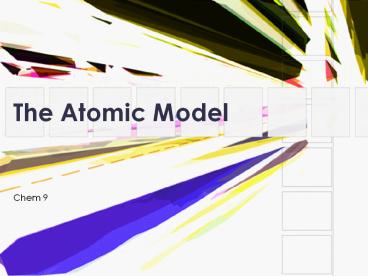The Atomic Model PowerPoint PPT Presentation
Title: The Atomic Model
1
The Atomic Model
- Chem 9
2
The Greek Model
- Democritus - A Greek Philosopher, 400 BC.
- Concluded that matter could not be divided into
smaller and smaller pieces forever. - Eventually, the smallest piece of matter would be
found. - He used the word "Atomos meaning indivisible.
3
The Dalton Model Billiard Ball Model
- John Dalton - The English chemist that proposed
- first Atomic Theory in 1803.
- All elements are composed of indivisible
particles. - Atoms of the same element are exactly alike.
- Atoms of different elements are different.
- Compounds are formed by joining atoms of two or
more elements
4
The Thomson Model Chocolate Chip Cookie
ModelPlum Pudding Model
- J. J. Thomson 1856 1940 (English scientist)
- discovered negative particle (an Electron) in
1887 - by using a cathode ray tube
- initially called electrons CORPUSLES
5
Robert A. Millikan (1868 1953)
- 1900 mass of Electron approximately 1/2000 the
mass of a Hydrogen atom - 1916 -determined the charge carried by an
electron - Millikan OIL DROP EXPERIMENT
6
Eugene Goldstein (1850 -1930)
- 1866 Eugene Goldstein found Positive particle
Protons - He named them CANAL RAYS
7
Sir James Chadwick 1891 - 1974
- Discovered
- the neutron in 1932
- Has no charge
- Neutrons mass is close to protons mass
8
Ernest Rutherford - British Physicist Gold Foil
Experiment
- In 1908, proved the atom had a small,
- dense, positively charged Nucleus.
- He said an atom is mostly empty space and
- negative electrons are scattered around
- the outside edge.
9
Niels Bohr (Danish scientist)The Planetary
Model - 1913
- Bohr proposed
- Electrons move in definite orbits around the
nucleus, like planets moving around the sun. - That each electron moves in a specific energy
level.
10
Quantum Mechanical Model
- Erwin Schrodinger (1887-1961)
- -Electrons have NO definite path in an atom.
- -Only a probable location is known based
- on how much energy it has.
- -Atomic orbitals (s,p,d,f) are NOT fixed paths
as Bohr suggested
11
(No Transcript)
12
Summary
- Dalton Solid Sphere
- Thomson Pos. neg mixed together
- Rutherford Positive nucleus, neg electrons
surrounding it - Bohr Positive nucleus, neg electrons in exact
orbits - Quantum Mechanical Theory
- (Electron cloud theory)
PowerShow.com is a leading presentation sharing website. It has millions of presentations already uploaded and available with 1,000s more being uploaded by its users every day. Whatever your area of interest, here you’ll be able to find and view presentations you’ll love and possibly download. And, best of all, it is completely free and easy to use.
You might even have a presentation you’d like to share with others. If so, just upload it to PowerShow.com. We’ll convert it to an HTML5 slideshow that includes all the media types you’ve already added: audio, video, music, pictures, animations and transition effects. Then you can share it with your target audience as well as PowerShow.com’s millions of monthly visitors. And, again, it’s all free.
About the Developers
PowerShow.com is brought to you by CrystalGraphics, the award-winning developer and market-leading publisher of rich-media enhancement products for presentations. Our product offerings include millions of PowerPoint templates, diagrams, animated 3D characters and more.

